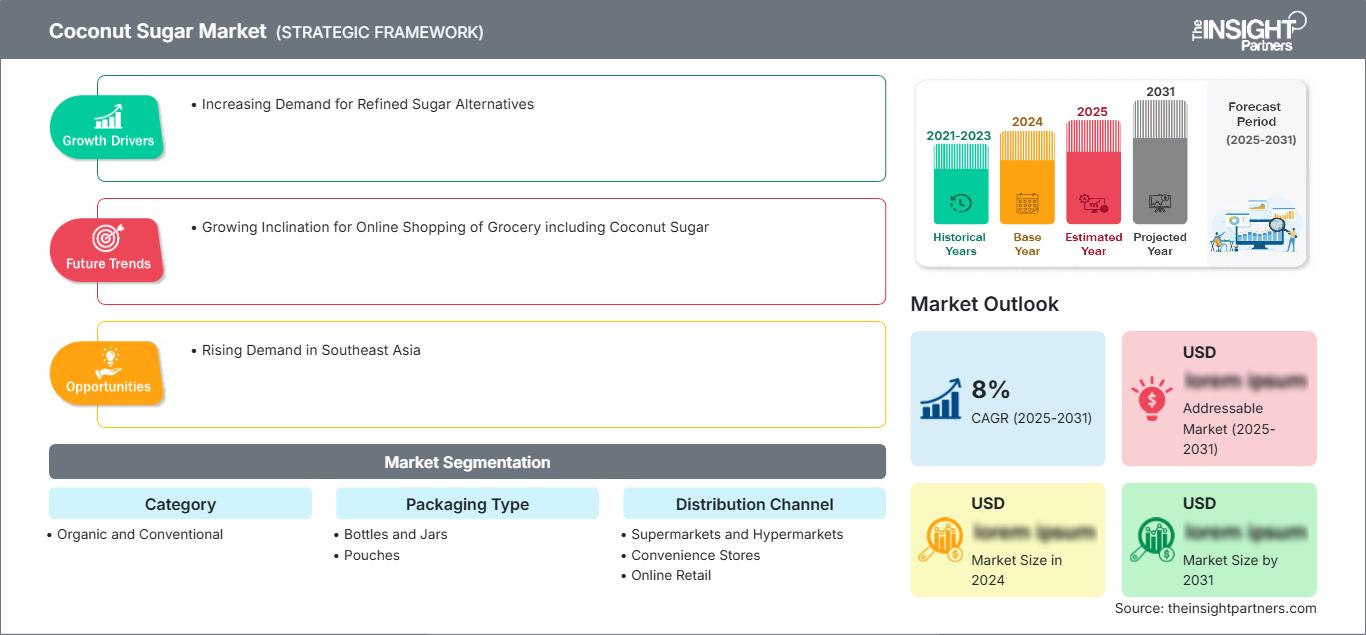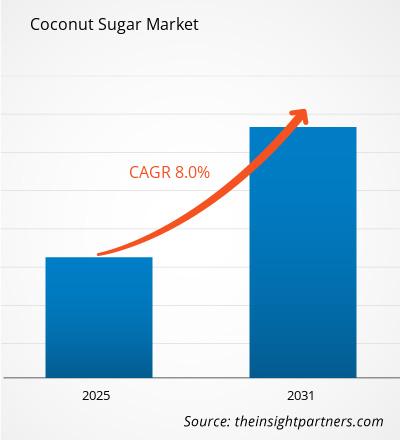Der Markt für Kokosnusszucker wird zwischen 2023 und 2031 voraussichtlich eine durchschnittliche jährliche Wachstumsrate von 8 % verzeichnen. Die zunehmende Neigung zum Online-Shopping von Lebensmitteln, einschließlich Kokosblütenzucker, wird voraussichtlich ein wichtiger Markttrend bleiben.
Marktanalyse für Kokosblütenzucker:
- In den letzten Jahren hat der Markt für Kokosblütenzucker ein starkes Wachstum erlebt, das auf Faktoren wie hohen Konsum, steigende Bevölkerungszahlen und technologischen Fortschritt zurückzuführen ist.
- Kokosblütenzucker ist ein natürliches Süßungsmittel, das aus dem Saft der Kokospalme gewonnen wird, indem Nektar aus den Blütenknospen gewonnen, gekocht und getrocknet wird.
- In Südostasien ist er ein weit verbreitetes natürliches Süßungsmittel, da er dort seit Hunderten von Jahren angebaut wird.
- In beiden Fällen ist einer der Hauptfaktoren, der das Wachstum des Kokosblütenzuckermarktes voraussichtlich vorantreiben wird, der zunehmende globale Trend der Verbraucher, natürliche und gesunde Süßungsmittel zu bevorzugen.
- Kokosblütenzucker ist gesünder als raffinierter Zucker, da er nicht verarbeitet wird und einen niedrigeren glykämischen Index hat. Er ist außerdem reich an Nährstoffen wie Kalium, Magnesium, Zink und Aminosäuren. Dies hat die Aufmerksamkeit gesundheitsbewusster Verbraucher deutlich auf sich gezogen.
Marktübersicht für Kokoszucker
- Mit dem wachsenden Trend zur Verwendung in der Lebensmittel- und Getränkeindustrie, insbesondere bei Naturkostprodukten, wird der Markt für Kokoszucker im Prognosezeitraum ein deutliches Wachstum verzeichnen.
- Auch in Europa wird Kokoszucker zunehmend für Lebensmittel-, Getränke- und Kosmetikanwendungen konsumiert.
- Der Markt ist jedoch aufgrund der Schwierigkeiten bei der Beschaffung junger Kokosnüsse mit Herausforderungen verbunden. Trotz dieser Herausforderungen wird aufgrund der gesundheitlichen Vorteile von Kokoszucker und des Trends der Lebensmittel- und Getränkeindustrie zur Verwendung natürlicher Süßstoffe davon ausgegangen, dass der Markt in Zukunft weiter wachsen wird.
Passen Sie diesen Bericht Ihren Anforderungen an
Sie erhalten kostenlos Anpassungen an jedem Bericht, einschließlich Teilen dieses Berichts oder einer Analyse auf Länderebene, eines Excel-Datenpakets sowie tolle Angebote und Rabatte für Start-ups und Universitäten.
Kokosnusszuckermarkt: Strategische Einblicke

-
Holen Sie sich die wichtigsten Markttrends aus diesem Bericht.Dieses KOSTENLOSE Beispiel umfasst Datenanalysen, die von Markttrends bis hin zu Schätzungen und Prognosen reichen.
- Das Wachstum des Kokoszuckermarktes wird durch die weltweit steigende Nachfrage nach Zuckeralternativen vorangetrieben, die wiederum auf die Suche der Verbraucher nach natürlichen und gesunden Süßungsmitteln zurückzuführen ist.
- Heutzutage sind sich die Menschen der Gesundheitsproblematik bewusst und beginnen, sich für natürliche und biologische Lebensmittel und Getränke zu interessieren. Daher entstehen immer mehr beliebte Zuckeralternativen. Eine davon ist Kokoszucker.
- Der Hauptgrund, warum Menschen Kokoszucker als Alternative zu herkömmlichen Süßungsmitteln wählen, ist die Gesundheit. Kokoszucker ist ein weniger verarbeitetes Süßungsmittel, das angeblich gesünder als raffinierter Zucker ist. Darüber hinaus wird die neue Zutat auch wegen ihres einzigartigen Geschmacks bevorzugt.
Chancen: Steigende Nachfrage in Südostasien
- Der wichtigste Verbrauchermarkt für Kokoszucker liegt in Südostasien, insbesondere in Indonesien. Der Lebensmittel- und Getränkesektor hat Kokosnusszucker aufgegriffen, insbesondere im Bereich der schnelldrehenden Konsumgüter (FMCG).
- Der Kokosnusszuckermarkt bietet folgende Chancen: Produktdiversifizierung, funktionelle Mischungen für gesundheitsbewusste Verbraucher, Wachstum der Lebensmittel- und Getränkeindustrie, zunehmendes Potenzial auf dem europäischen Markt; und die wachsende Nachfrage in Südostasien.
Marktsegmentierung für Kokoszucker
Der globale Markt für Kokoszucker wurde nach Verpackungsart, Kategorie und Vertriebskanal segmentiert.
- Basierend auf der Verpackungsart ist der Markt für Kokoszucker in Flaschen und Gläser, Beutel und andere unterteilt.
- Auf der Grundlage der Kategorie ist der Markt in Bio und konventionell unterteilt.
- Basierend auf dem Vertriebskanal ist der Markt in Supermärkte und Hypermärkte, Convenience Stores, Online-Einzelhandel und andere segmentiert.
Marktanteilsanalyse für Kokoszucker nach Geografie
- Der Marktbericht für Kokoszucker umfasst eine detaillierte Analyse von fünf großen geografischen Regionen, einschließlich der aktuellen und historischen Marktgröße und Prognosen für 2021 bis 2031, die Nordamerika, Europa, den asiatisch-pazifischen Raum (APAC), den Nahen Osten und Afrika (MEA) sowie Süd- und Südamerika abdecken. Mittelamerika.
- Jede Region ist weiter in entsprechende Länder unterteilt. Dieser Bericht bietet Analysen und Prognosen für über 18 Länder und deckt die Marktdynamik von Kokoszucker ab, wie z. B. Treiber, Trends und Chancen, die die Märkte auf regionaler Ebene beeinflussen.
- Darüber hinaus umfasst der Bericht Porters Fünf-Kräfte-Analyse, die die Untersuchung der wichtigsten Faktoren umfasst, die den Kokoszuckermarkt in diesen Regionen beeinflussen.
Kokosnusszuckermarkt
Die Analysten von The Insight Partners haben die regionalen Trends und Faktoren, die den Kokoszuckermarkt im Prognosezeitraum beeinflussen, ausführlich erläutert. In diesem Abschnitt werden auch die Marktsegmente und die geografische Lage in Nordamerika, Europa, dem asiatisch-pazifischen Raum, dem Nahen Osten und Afrika sowie Süd- und Mittelamerika erörtert.Umfang des Kokoszucker-Marktberichts
| Berichtsattribut | Einzelheiten |
|---|---|
| Marktgröße in 2024 | US$ XX million |
| Marktgröße nach 2031 | US$ XX Million |
| Globale CAGR (2025 - 2031) | 8% |
| Historische Daten | 2021-2023 |
| Prognosezeitraum | 2025-2031 |
| Abgedeckte Segmente |
By Kategorie
|
| Abgedeckte Regionen und Länder |
Nordamerika
|
| Marktführer und wichtige Unternehmensprofile |
|
Dichte der Marktteilnehmer für Kokoszucker: Verständnis ihrer Auswirkungen auf die Geschäftsdynamik
Der Markt für Kokoszucker wächst rasant, angetrieben von der steigenden Nachfrage der Endverbraucher. Diese Entwicklung ist auf Faktoren wie veränderte Verbraucherpräferenzen, technologische Fortschritte und ein stärkeres Bewusstsein für die Produktvorteile zurückzuführen. Mit der steigenden Nachfrage erweitern Unternehmen ihr Angebot, entwickeln Innovationen, um den Bedürfnissen der Verbraucher gerecht zu werden, und nutzen neue Trends, was das Marktwachstum weiter ankurbelt.

- Holen Sie sich die Kokosnusszuckermarkt Übersicht der wichtigsten Akteure
Der Kokoszuckermarkt wird durch die Erhebung qualitativer und quantitativer Daten aus Primär- und Sekundärforschung bewertet, die wichtige Unternehmenspublikationen, Verbandsdaten und Datenbanken umfasst. Im Folgenden finden Sie eine Liste der Entwicklungen auf dem Markt für Innovationen, Geschäftserweiterungen und Strategien:
- Heute wird die neueste globale Nachhaltigkeitsplattform im Rohstoffbereich, die Sustainable Coconut Partnership (The Partnership), eingeführt. Ziel ist es, eine verantwortungsvolle Kokosnussproduktion und Markttransformation in großem Maßstab zu katalysieren, indem branchenweite Best Practices und Wirkungsprogramme etabliert und die Branchenanforderungen an ihre Lieferkettenpartner weiter harmonisiert werden. (Quelle: The Sustainable Coconut PartnerShip, Pressemitteilung, April 2023)
Bericht zum Kokoszuckermarkt: Abdeckung und Ergebnisse
Der „Markt für Kokoszucker – Größe und Prognose (2021 – 2031)“ bietet eine detaillierte Analyse des Marktes, die die folgenden Bereiche abdeckt:
- Marktgröße und Prognose für Kokoszucker auf globaler, regionaler und Länderebene für alle abgedeckten wichtigen Marktsegmente.
- Markttrends und Marktdynamiken für Kokoszucker wie Treiber, Einschränkungen und wichtige Chancen
- Detaillierte PEST/Porters Five Forces- und SWOT-Analyse
- Marktanalyse für Kokoszucker mit wichtigen Markttrends, globalen und regionalen Rahmenbedingungen, wichtigen Akteuren, Vorschriften und aktuellen Marktentwicklungen.
- Branchenlandschaft und Wettbewerbsanalyse mit Marktkonzentration, Heatmap-Analyse, prominenten Akteuren und aktuellen Entwicklungen für den Kokoszuckermarkt.
- Detaillierte Firmenprofile
- Historische Analyse (2 Jahre), Basisjahr, Prognose (7 Jahre) mit CAGR
- PEST- und SWOT-Analyse
- Marktgröße Wert/Volumen – Global, Regional, Land
- Branchen- und Wettbewerbslandschaft
- Excel-Datensatz
Aktuelle Berichte
Verwandte Berichte
Erfahrungsberichte
Grund zum Kauf
- Fundierte Entscheidungsfindung
- Marktdynamik verstehen
- Wettbewerbsanalyse
- Kundeneinblicke
- Marktprognosen
- Risikominimierung
- Strategische Planung
- Investitionsbegründung
- Identifizierung neuer Märkte
- Verbesserung von Marketingstrategien
- Steigerung der Betriebseffizienz
- Anpassung an regulatorische Trends






















 Kostenlose Probe anfordern für - Kokosnusszuckermarkt
Kostenlose Probe anfordern für - Kokosnusszuckermarkt